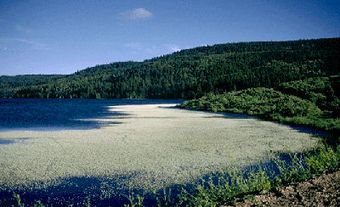Views: Hopewell Rocks by Google Maps
Mammoth pillars, the Rocks, rise out of the sea at Hopewell Cape on New Brunswick's southern coast. The Rocks Provincial Park (established 1958, 120 ha) is located halfway between Moncton and Fundy National Park. Forests, farms, old homesteads, dyked marshes and now-closed gypsum mines are found in the surrounding area.
Natural History
Located along Shepody Bay at the mouth of the Petitcodiac River, the Rocks have been described as giant flower pots referring to the trees that grow on top of the pillars. They can be viewed from the top of cliffs or, at low tide, visitors can descend the cliffs to explore the shore.
At the shore, the tides of Fundy, the highest tides in the world, ebb and flow, creating an extensive intertidal zone. The mudflats of the bay are a major stopover for thousands of migrating shorebirds, particularly sandpipers. During August, the birds feed on tiny crustaceans before they depart south in September. The forests of the park are part of the Atlantic Maritime natural region and are characterized by spruce, hemlock, white birch and fir.
Origins
According to Mi'kmaq legend, people were enslaved by great whales that once lived in Bay of Fundy. On seeing a chance to escape, the people dashed for the shore, but not fast enough. The angry whales turned them all to stone, creating the Rocks.
Geologists have another explanation. Nearly 300 million years ago, fast-flowing streams brought sand and pebbles from the nearby Caledonia Mountains. This material was deposited in layers and over time formed beds of conglomerate and sandstone. Later, the region was disturbed by the great forces of thrusting, folding and glaciation. The layers of rock were tilted and cracked by vertical fractures, now reflected in the rough rectangular shape of the Rocks.
Erosion by melt waters from the last glaciers isolated the pillars. When the last ice sheet retreated 10 000 years ago, cliffs and pillars became exposed to the tidal forces of the Bay of Fundy. Cliffs at the shore continue to be eroded, forming new pillars. Older formations are eventually toppled by the tides.

 Share on Facebook
Share on Facebook Share on X
Share on X Share by Email
Share by Email Share on Google Classroom
Share on Google Classroom

